
I understand how frustrating it can be when your ice maker decides to take a day off. There you are, expecting a refreshing drink garnished with ice cubes, and instead, you’re left with a lukewarm beverage. It’s more than just a minor inconvenience; it’s a hiccup in your daily routine.
“Fix ice maker hassles with our Samsung fridge guide!”
My aim here is simple: to guide you through solving the cold puzzle posed by your Samsung refrigerator’s ice maker. By the time you reach the end, not only will you be more knowledgeable about what could be going wrong, but you will have practical advice at your fingertips to potentially fix it yourself.
Trust me, I’ve been around the refrigerator block a few times. I’ll break down the information in a way that’s easy for you to understand. Rest assured, you’re getting advice from someone who truly knows the ins and outs of these chilly machines.
When Ice Becomes Nice: Understanding Common Ice Maker Problems
I get how frustrating it can be when you reach for an ice-cold drink and find your ice maker on strike. Imagine you’re hosting a get-together, and your Samsung refrigerator isn’t churning out ice as it should. Not exactly the chill vibe you planned for, right?
Some issues are more frequent than others. For instance, maybe your ice maker isn’t producing any ice at all, or it’s making very little. Perhaps the ice cubes are coming out misshapen, or the machine is jamming, causing a mini avalanche every time you open the freezer.
Other common woes might include a leaky ice maker, an ice maker making too much noise, or one that’s dispensing ice slower than molasses in January.
Each of these problems can disrupt your day, but they also give us clues. A lack of ice production could point to a water supply issue, while odd-shaped cubes might mean a temperature problem.
Remember, these problems are not unique to your kitchen. They occur in many homes, so there’s a wealth of troubleshooting experience to draw upon. If your ice maker is more ‘room temp’ than ‘arctic chill,’ don’t worry. I’m here to help you get to the bottom of it.
Troubleshooting Samsung Refrigerator Ice Maker Issues
- No ice production
- Ice maker leaks
- Ice tastes bad
- Ice maker making noise
- Ice cubes are small or misshapen
- Ice maker freezes over
- Ice maker not dispensing properly
Diving Deep into the Chill: Identifying Possible Damaged Parts
When your Samsung refrigerator ice maker is on the fritz, understanding the interplay of its parts is crucial. The problem often lies not at the surface but within the mechanics of the unit. I’ll help you identify which components might be responsible for your ice maker’s poor performance.
First up, we’ve got the water inlet valve. When this part malfunctions, it can stop water from reaching the ice maker, meaning no ice for you. Then there’s the ice maker assembly itself, a complex part where things can go wrong internally.
The thermostat within the ice maker monitors the temperature, triggering the release of ice when it’s frozen. A faulty thermostat can leave you with an ice tray that’s all water or a bin overflowing with ice. Don’t overlook the simplicity of a jammed ice bucket, too, which can impede the machine’s operation.
For machines with a control arm or switch, you want to make sure these are in the correct position. Accidental nudging can halt production instantly. And finally, if your model boasts an electronic control board, this mini-brain of the ice-making process might be misfiring.
Your refrigerator is a symphony of parts that must all work in harmony. Discovering which note is off-key is your ticket to restoring the melody. But where do you start? Our next section lays out the sequence of steps to follow—a practical approach to play detective with your ice maker.
Commonly Damaged Parts of Samsung Refrigerator Ice Makers
- Ice maker tray
- Water inlet valve
- Ice maker assembly
- Dispenser motor
- Temperature sensor
- Ice maker control module
- Water filter
- Ice mold thermostat
- Dispenser switch
- Auger motor
Ice Maker Parts:
- Samsung Refrigerator Ice Maker Troubleshooting Guide
- 2198597 Whirlpool Refrigerator Ice Maker
- Supco 4317943 Refrigerator Ice Maker
- D7824706Q Refrigerator Icemaker for Whirlpool Maytag Kenmore
- WP4317943 Whirlpool Refrigerator Ice Maker
Note: Click here to view more Refrigerator Replacement Parts.
The Cool Path Forward: A Step-by-Step Troubleshooting Guide
You need ice and you need it now, but your Samsung refrigerator’s ice maker has other plans. Don’t panic. I’m going to walk you through a practical, systematic approach to troubleshoot the unit. By the end, you’ll either have a working ice maker or a clear idea of what’s wrong.
Make sure the ice maker is ON. It’s basic, but sometimes simple oversights are the culprits. Check the control panel or the switch on the ice maker itself, depending on your model.
Inspect the water supply line for kinks or blockages. A disrupted water flow can halt ice production faster than a winter thaw.
Check if the filter is clogged. When was the last time you replaced it? Old filters obstruct water flow, affecting ice quality and quantity.
Examine the ice bucket for clumped ice. If you find any, it’s DEFROST time. Remove the chunks, because these can block the dispenser mechanism.
Test the ejector blades. Are they stuck or obstructed? Gently push them to see if they move freely. If they don’t, ice accumulation could be to blame.
Observe the freezer temperature. Ice makers have a sweet spot: 0°F (-18°C). If your freezer is not cold enough, it’s time to troubleshoot why.
If you’ve walked through these steps and the issue persists, it could be time to dig deeper or call a pro. But before that, let’s talk about how to keep your ice maker functioning smoothly for as long as possible.
Get Your Ice Maker Back on Track: 8 Essential Checks for Samsung Refrigerators
Is your Samsung refrigerator’s ice maker giving you the cold shoulder? Don’t fret! Watch this video to discover the 8 crucial checks to revive your ice maker and enjoy icy goodness once again. From simple fixes to troubleshooting tips, we’ve got you covered. Say goodbye to ice maker woes and hello to chilled refreshment!
Easy Fixes: Samsung Refrigerator Ice Maker Guide
- Check water supply.
- Adjust temperature settings.
- Inspect ice maker tray.
- Clear any ice blockages.
- Verify water inlet valve.
- Examine dispenser mechanism.
- Reset ice maker.
- Clean water filter.
- Test ice maker components.
- Contact Samsung support if needed.
Preventative Measures: Ice Maker Maintenance Tips
I understand the frustrations of ice maker malfunctions. Regular preventive maintenance is the best way to avoid these irritations. Here, I’m going to share practical advice on how to maintain your Samsung refrigerator’s ice maker, promoting its efficiency and longevity.
Start with the basics: give your ice maker a routine cleaning every six months. This isn’t just about wiping the exterior; I’m talking about unplugging the fridge and allowing the ice bin to dry out completely. By preventing ice buildup and ensuring the bin is dry, you help thwart mildew and mold, which could interfere with the mechanics or degrade ice quality.
Next, inspect the water filter and replace it as recommended by your Samsung manual. A fresh filter not only leads to purer tasting ice but also protects the ice maker from sediment build-up that can clog and damage it.
Keep an eye on the freezer temperature, too. The ideal range is between 0 to 5 degrees Fahrenheit. If the temperature strays from this zone, it can affect ice production. Use an appliance thermometer to monitor it, ensuring your ice maker has the optimal conditions to work in.
Finally, don’t forget to check for firmware updates if your Samsung refrigerator is a smart model. These updates can fix known issues and improve the performance of your ice maker.
Consistent maintenance not only makes your ice maker reliable but also catches small issues before they turn into big problems. With these tips, you’re well-equipped to keep your ice maker in top shape. Stay cool and enjoy the convenience of uninterrupted ice production.
Wrapping Up the Cold Case: Concluding Your Ice Maker Troubleshooting Journey
You’ve now stepped through a practical path, equipped with the knowledge to tackle common ice maker issues. Having this guide at your disposal ensures you’re never left puzzled by your Samsung refrigerator’s quirks. You’ve learned to identify signs of trouble, understand the problems that lay within, and navigate the steps to potentially fix them yourself. And remember, sometimes the best fix is preventing the issue in the first place, which is where your newfound maintenance tips come in.
If you’ve followed the steps and still encounter frosty frustrations, don’t hesitate to contact a professional. There’s no shame in seeking help; in fact, it’s a smart move to protect your appliance and your peace of mind. Also, consider that warranty or service plans could be your ally here.
As you close this chapter of your refrigerator’s story, remember that regular care can make a world of difference. Stay vigilant, keep those maintenance tips in regular practice, and your ice maker should serve you well for many chilled beverages to come.
I’d love to hear how this guide helped you out or if there’s more you’d like to know. Your feedback not only warms my heart but also helps me provide even better content for readers like you. So go ahead, drop a comment, share your story, or just say hi—a little conversation is always welcome in the world of troubleshooting!
Q&A
Q&A 1: Q: Why is my Samsung refrigerator not making ice? A: Check water supply, temperature settings, and ice maker components for issues.
Q&A 2: Q: How can I troubleshoot a jammed ice maker? A: Clear ice blockages, examine the dispenser, and inspect the ice maker assembly.
Q&A 3: Q: What should I do if my ice cubes are too small? A: Adjust water pressure, check for clogs, and ensure proper ice maker function.
Q&A 4: Q: Why is my Samsung fridge leaking water? A: Inspect water lines, assess the defrost drain, and check for leaks in the ice maker.
Q&A 5: Q: How do I reset my Samsung refrigerator ice maker? A: Follow the manufacturer’s instructions or power cycle the refrigerator.
Q&A 6: Q: How often should I replace the water filter? A: Replace every 6 months or as recommended by Samsung to maintain water quality.
Q&A 7: Q: Can I manually fill the ice maker? A: Yes, use a container to add water directly to the ice maker if needed.
Q&A 8: Q: What causes my ice maker to freeze up? A: Insufficient water flow, defective components, or improper temperature settings may lead to ice buildup.
Q&A 9: Q: Is it normal for my ice maker to make noise? A: Some noise during ice production is typical, but loud or unusual sounds may indicate an issue.
Q&A 10: Q: Why is there a bad taste in my ice? A: Replace the water filter, clean the ice maker components, and ensure proper water quality for better-tasting ice.
You Might Need These:
- 4204280 Sub-Zero Refrigerator Control Board 3015960 AZ27864
- Used GE Refrigerator Control Panel WR55X10914 WR55X10163
- Used GE Monogram Refrigerator Control Panel WR55X10916 WR55X10158
- 240337103 Frigidaire Refrigerator Crisper Drawer Pan
- 240323002 Refrigerator Lower Door Shelf Bin


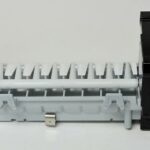

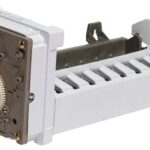
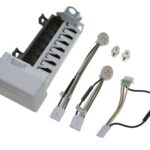



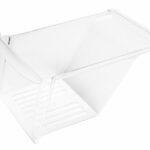
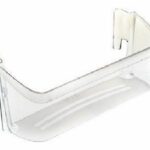

I took the ice maker out but can’t get it back in again! What is wrong?
Hi Stephanie,
Please contact professional service here. https://www.samsung.com/uk/support/home-appliances/my-samsung-fridge-freezer-ice-maker-does-not-produce-enough-ice-what-should-i-do/
Best regards,